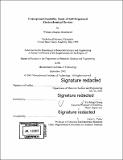| dc.contributor.advisor | Yet-Ming Chiang. | en_US |
| dc.contributor.author | Moorehead, William Douglas,S. M.Massachusetts Institute of Technology. | en_US |
| dc.contributor.other | Massachusetts Institute of Technology. Department of Materials Science and Engineering. | en_US |
| dc.date.accessioned | 2020-09-25T20:04:22Z | |
| dc.date.available | 2020-09-25T20:04:22Z | |
| dc.date.copyright | 2002 | en_US |
| dc.date.issued | 2002 | en_US |
| dc.identifier.uri | https://hdl.handle.net/1721.1/127719 | |
| dc.description | Thesis: S. M., Massachusetts Institute of Technology, Department of Materials Science and Engineering, 2002 | en_US |
| dc.description | Cataloged from the PDF of thesis. | en_US |
| dc.description | Includes bibliographical references. | en_US |
| dc.description.abstract | Since Volta's discovery of " an electric battery" in 1800, advancements have proceeded due to great materials advances. However, the basic configuration he proposed then is still present in today's portable power sources. In this work, using attractive and repulsive London-van der Waals forces, a self-organized, interpenetrating, separator-free rechargeable lithium ion battery called a self-organized battery system (SBS) is proposed. In this design, a repulsive interaction between the cathode and anode is used to establish the basic electrochemical junction. Increases in both energy density (Wh/kg, Wh/1) and power density (W/kg, W/1) are possible from such a design, due to 1) the decrease of inactive materials required, and 2) the decrease in Li ion diffusion length between the cathode and anode. The sign of the Hamaker constant (A₁₂₃) determines either attraction (+) or repulsion(-) where material 2 is the intervening material between materials 1 and 3. | en_US |
| dc.description.abstract | For low refractive index materials (n<2), A₁₂₃ is determined primarily by the average refractive index of materials 1,2, and 3 in the visible range. For a repulsive interaction, where A₁₂₃<0, the refractive index of materials 1,2, and 3 must be n₁<n₂<n3, or n₁>n₂>n₃ All close packed oxide cathode structures (LiMO₂,where M=Mn, Co, Ni) that are currently used in Li ion technology have refractive indexes >2. However, a new class of cathode materials based upon the olivine, LiFePO₄, allows n₁<n₂<n₃ to be achieved with the use of organic solvents as the intervening medium. Furthermore, low refractive index conductive/insulating polymer blends were studied as a potential coating on LiMO₂ cathode materials. Single-wave ellipsometry measurements were taken on doped LiFePO₄ and the polymer blends in order to determine the refractive index. | en_US |
| dc.description.abstract | Electronic isolation between the conductive polymer blend and both MCMB and Mg-doped LiCoO₂ was achieved as well as between doped LiFePO₄ and MCMB. Electrochemical cycling was performed on several SBS cells. Upon electrochemical cell assembly, open circuit voltages were observed. Upon cycling, The cell voltages observed upon intercalation are thermodynamically consistent with the cathode and anode materials present in the systems. Comparisons to conventional cells using Celgard separator between the cathode and anode are made. | en_US |
| dc.description.statementofresponsibility | by William Douglas Moorehead. | en_US |
| dc.format.extent | 77 pages | en_US |
| dc.language.iso | eng | en_US |
| dc.publisher | Massachusetts Institute of Technology | en_US |
| dc.rights | MIT theses may be protected by copyright. Please reuse MIT thesis content according to the MIT Libraries Permissions Policy, which is available through the URL provided. | en_US |
| dc.rights.uri | http://dspace.mit.edu/handle/1721.1/7582 | en_US |
| dc.subject | Materials Science and Engineering. | en_US |
| dc.title | Concept and feasibility study of self-organized electrochemical devices | en_US |
| dc.type | Thesis | en_US |
| dc.description.degree | S. M. | en_US |
| dc.contributor.department | Massachusetts Institute of Technology. Department of Materials Science and Engineering | en_US |
| dc.identifier.oclc | 1196185530 | en_US |
| dc.description.collection | S.M. Massachusetts Institute of Technology, Department of Materials Science and Engineering | en_US |
| dspace.imported | 2020-09-25T20:04:21Z | en_US |
| mit.thesis.degree | Master | en_US |
| mit.thesis.department | MatSci | en_US |
